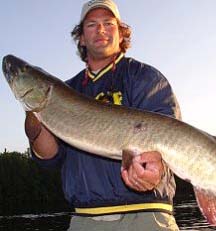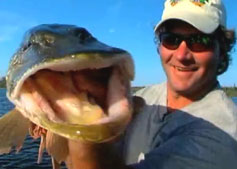
With today’s wealth of information available via the internet, T.V., magaizne articles, or just plain sharing information with fishing buddies, musky fishermen have more short cuts than ever before. Hot spots are marked all over maps, GPS waypoints are shared, and nothing seems secret anymore. There is only one thing, none of this information does you any good unless you understand the locations and attack them from the proper angles.
Wind Direction
Wind direction is always key. I always try to fish structures that have wind blowing into them, or did have wind blowing into them the prior in the day or actually the day prior. With that said, certain lakes may accommodate better wind directions than others. Lakes that have structures protruding from the east or north will best be suited for a west or southwest wind for example.
Humps and/or Mid-lake Structures
Everyone can find a hump or rock pile in the middle of the lake with today’s GPS units, but just because there is a hump that tops out at 10 feet, doesn’t mean that the top is the spot on the spot. A lot of times there are spines or fingers that jet out from the top of the structure that go way overlooked. Drive around the hump and watch for subtle changes in depth, look for flat areas that stretch out and away from the main top. These are the locations that are prime. Sometime there are underwater saddles that connect a nearby hump and these deeper structures will hold the larger fish from time to time, especially in the fall.
Weedlines and inside turns
Inside turns and weed points are the two best ambush locations for muskies, when referring to weed structures. Being able to identify these locations isn’t that hard to do. A point is just that, where a weedline travels out into the lakes basin and suddenly stops. There is usually a significant drop in depth after this. An inside turn is best described as a straight weedline that dips towards the shore before turning and jetting out into the lake’s basin leading to the weed point itself. Couple an inside turn with a direct wind blowing into it, and there will be feeding muskies around.
Attacking the areas
After describing the typical structures of a lake, and how they are defined, comes the next step. How should these areas be fished? Pointless casting and flinging lures around without paying attention to depth isn’t the best way to going about it. Sure, a fish can be caught this way, but luck with definitely play a part in this.

Weedlines
When my boat fishes weedlines, all bases are covered. The person in the front of the boat covers the edge and secondary break. This means casting parallel and slight outwards from the weedline. The boat is positioned usually about 2/3 of a cast from the actual weeds. The second person in the boat covers the weed flat and works perpendicular to the weedline, while I in the back of the boat cover the tops and the edge again while casting out of the back of the boat. Some effective lures for the edge are Depth Raiders, Ernies, and Bulldawgs. These lures can be worked down deeper and are very effective at locating fish along the weed edge. Lures to cover the tops and flat part of the weedbed are bucktails (Windels, Blue Fox SuperVibrax, Voodoo Tails), jerkbaits (Suicks, Burts, Reef Hawgs), and topwaters (Pacemakers, Topper Stoppers, Top Raiders). You will generally be working with the wind, so control your boat very particularly. Pay close attention to depth and don’t let the boat get into the weeds themselves, stay out and away from the weeds.
Rocks Humps
These structures are easy to fish, once the known location is figured out. I sometime will throw a marker buoy on the top of a bar and them motor upwind and set up controlled drifts and work towards the marker. Casting around a rock hump should be set up so the lures are spread out and different depths are reached. Depending upon size of the structure, several drifts may be needed to cover the entire area thoroughly. I like to have 2 lures casted at the structure, while one lure gets tossed off into no-man’s land looking a suspended fish lurking off the structure. Lure choices are relative to the depth of the structure and what is actually on it. Some mid-lake humps can be shallow and weed covered, while others may be all rock and deep. Crankbaits, large plastics, different bucktails, jerkbaits (weighted and unweighted), minnow bait can all be effective. Pick lures that will cover the water columns effectively. I like to take a bead on the marker buoy and then drift towards the buoy and take slices of water from left to right until I feel that the entire structure was covered. I seldom fish the downwind side of a mid-lake structure, so once the boat is just past the buoy it is time to pick up and start again.
I hope this gives a little insight on proper boat handling and attacking different structures of a lake correctly. Pay attention to detail and the dividends will be felt at the end of the rod.










